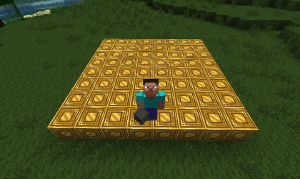Blog
What Minecraft
Can Teach You
About Neutron Stars
15 July 2018
 Brian Koberlein
Brian KoberleinWhenever I need to clear my mind, or try to think of a topic for my next blog post, I usually either go for a run or play video games. Since there’s been a heat wave in my area recently, so I’ve stuck to video games. Most recently it’s been Minecraft.
One of the aspects of Minecraft is finding stuff and putting into your backpack. Punch trees to get blocks of wood, dig for iron, find villages and “borrow” carrots and potatoes, etc. It doesn’t take long for your pack to fill up, and then you have to start choosing what you really need, and what you can toss to free up space. While it always seems limiting, your pack is ridiculously generous. It has 36 available slots, each for a separate type of thing. Some things like swords or shovels completely fill up their own slot, but for raw materials like wood or iron ore, you can put up to 64 items in a single slot. So in principle you can have 36 slots each filled to the top, for a total of 2,304 items. Unlike some games that estimate some kind of weight or volume limit, Minecraft only cares about slots. If there’s a free slot, you can add it to the pack.
It’s easy to see how ridiculous this is. Minecraft is block-based, and each block is supposed to be about a cubic meter in size. A full pack of 2,304 cubic meters would form a cube more than 13 meters on a side, and your avatar is perfectly comfortable lugging all of it on their back. Of course in the game, once something is added to your pack, it’s volume doesn’t matter. Like most video game packs, there must be some magical effect that simply compresses it all into a reasonable size. Maybe those Pym particles used to explain the size changes of Ant-Man.
But what about mass? A couple thousand cubic meters of anything is going to have quite a bit of mass. Even the density of air at sea level is about 1 kilogram per cubic meter. If you filled every possible slot of your minecraft pack with air, it would literally weigh more than a ton. But how extreme could things get? In Minecraft, the heaviest single block you can make is one of solid gold. Gold has a density of 19,300 kg per cubic meter, so that means you could fit more than 44 million kilograms in the pack. All of that gets shrunk down to some managable size, say about the size of a baseball.
Of course video games aren’t beholden to the laws of physics. They can make their own rules to keep the game entertaining. But suppose we tried to make a real back of holding. Anything you toss into the bag gets compressed to a small volume. How much could we pack into our bag? Nature has given us a clear answer. There is a maximum amount of mass that can be compressed into a volume before it would collapse into a black hole. For the volume of a baseball, that’s about 20 trillion trillion kilograms, which is far more than the Minecraft limit.
But there’s a more subtle limit related to neutron stars. While a black hole is the ultimate limit, highly compressed objects have so much weight that there is a point where they would collapse under their own weight. This limit is called the Tolman-Oppenheimer-Volkoff limit. Beyond that limit a neutron star will collapse into a black hole. We aren’t exactly sure what that limit is, but it seems to be a bit more than 2 solar masses compressed into a sphere only 20 kilometers wide. At that density, the volume of gold in a minecraft pack would be compressed to a volume of a few cubic centimeters.
In other words, the upper limit of a Minecraft pack is about the same as the upper limit for a neutron star.